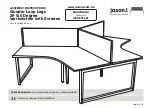
2.3 Pre-Installation Preparation
Advanced planning and preparation for the installation of your Trillium Compact seismometer
will ensure that you have a properly prepared site and the tools and materials you need readily
available. Follow these recommendations when preparing for your installation:
l
Gather your installation tools and materials. At a minimum you should have the
following on-site when installing your seismometer:
l
Digging tools for direct burial installation
l
Power source
l
Digitizer and cable. See
"Cables and Accessories" on page 12
for information on
cables and other accessories.
l
Compass for alignment. See
"Aligning a Trillium Compact Posthole to North" on
l
A laptop or mobile device with software and cables required to connect to and
communicate with the digitizer.
To save time during installation, the Trillium Compact and the Nanometrics digital recorder can
be pre-configured for deployment. See
"Configuring Your System" on page 58
.
2.4 Preventative Maintenance of Connectors
For the Trillium Compact Posthole, prior to each deployment, inspect the cable
connectors and grease them if needed. Once greased and mated the connectors will
be well protected and will not need to be serviced during the course of a field
deployment.
For the Trillium Compact Vault there are no special handling requirements.
For Trillium Compact Posthole seismometers, prior to each deployment, cable connectors
should be inspected and, if necessary, greased using the following guidelines:
l
Inspect, grease and mate the connectors at a warm temperature (above -20ºC) prior to
deployment if possible. (Below -20ºC connectors become stiff and cannot be mated.
However, once mated connectors can be used to -40ºC or lower.)
l
For standard temperature deployments, use Molykote 44, Molykote 111, or Dow
Corning 111 grease
Chapter 2 - Installing a Trillium Compact Posthole Seismometer
16889R10 • 2020-11-12
Page 19
















































